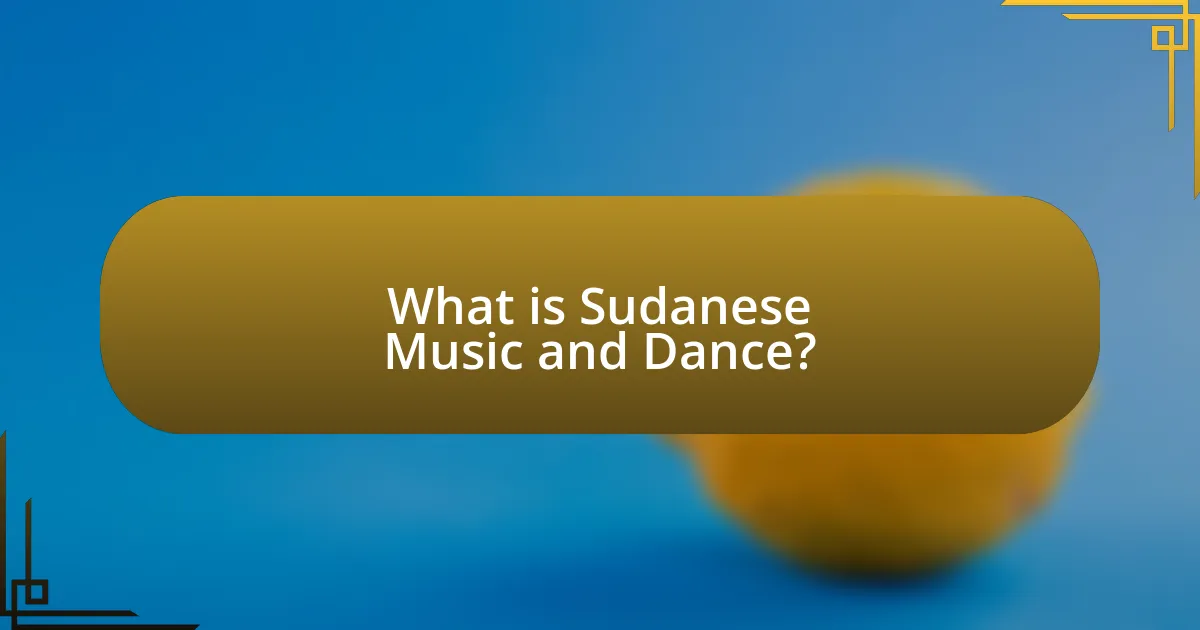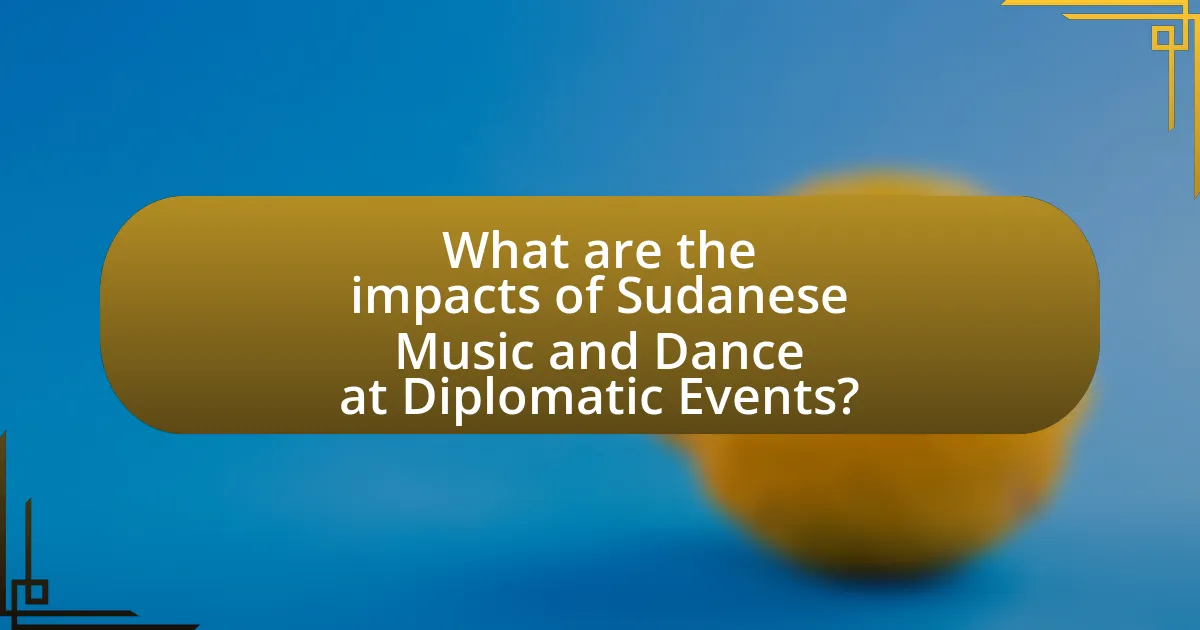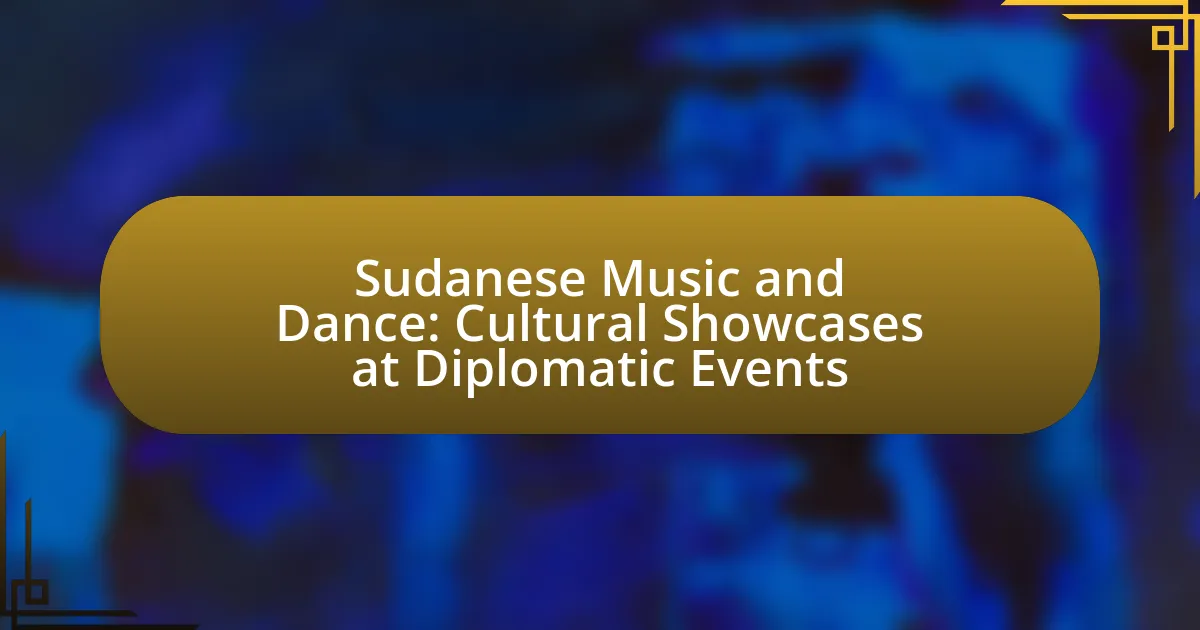Sudanese music and dance are vital aspects of Sudan’s cultural heritage, showcasing the country’s ethnic diversity through various traditional instruments and dance forms. This article explores how these art forms reflect cultural identity, historical influences, and regional variations, emphasizing their significance during social and religious events. Additionally, it examines the role of Sudanese music and dance in diplomatic contexts, highlighting their impact on cultural exchange and international perceptions of Sudan. Key elements such as instrumentation, rhythms, and performance practices are discussed, along with strategies for authentic representation and audience engagement at cultural showcases.

What is Sudanese Music and Dance?
Sudanese music and dance are integral components of Sudan’s cultural heritage, characterized by diverse styles that reflect the country’s ethnic and cultural diversity. The music often features traditional instruments such as the oud, tambour, and various percussion instruments, while the dance forms vary widely, including the energetic “Hawiya” and the graceful “Dabke.” These art forms serve not only as entertainment but also as a means of storytelling and cultural expression, often performed during significant events and celebrations. The historical context of Sudanese music and dance can be traced back to ancient traditions, with influences from Arab, African, and indigenous cultures, showcasing the rich tapestry of Sudan’s social and cultural identity.
How do Sudanese music and dance reflect cultural identity?
Sudanese music and dance reflect cultural identity by serving as vital expressions of the country’s diverse heritage and social values. The rhythms, instruments, and dance styles are deeply rooted in Sudan’s history, showcasing influences from various ethnic groups, including Nubian, Arab, and African traditions. For instance, the use of the oud and tambour in music highlights the Arab influence, while traditional dances like the “Hawiya” and “Dabke” emphasize community bonding and storytelling, reinforcing social cohesion. These art forms are often performed during significant cultural events and diplomatic gatherings, symbolizing national pride and unity among Sudanese people.
What are the historical influences on Sudanese music and dance?
Sudanese music and dance have been historically influenced by various cultures, including Arab, African, and indigenous traditions. The Arab influence is evident through the incorporation of instruments like the oud and the use of Arabic poetic forms, which were introduced during the Islamic expansion in the 7th century. African influences are reflected in the rhythmic patterns and dance styles that vary across Sudan’s diverse ethnic groups, such as the Nuba and Beja. Additionally, colonial interactions with British and Egyptian cultures in the 19th and early 20th centuries introduced new musical forms and instruments, further enriching Sudanese music and dance. These historical influences create a unique cultural tapestry that showcases Sudan’s rich heritage during diplomatic events.
How do regional variations impact Sudanese music and dance styles?
Regional variations significantly impact Sudanese music and dance styles by influencing the instruments used, the rhythms, and the thematic content of the performances. For instance, in northern Sudan, the use of the oud and the incorporation of Arabic musical scales are prevalent, reflecting the region’s historical ties to Arab culture. In contrast, southern Sudan showcases traditional instruments like the djembe and emphasizes African rhythms, which highlight the diverse ethnic backgrounds of the population. These regional distinctions are further exemplified in dance styles; for example, the energetic and communal dances of the Nuba Mountains differ markedly from the more fluid and individualistic movements found in the eastern regions. This diversity not only enriches Sudanese cultural expression but also serves as a representation of the country’s multifaceted identity at diplomatic events.
What are the key elements of Sudanese music?
The key elements of Sudanese music include traditional instruments, vocal styles, and rhythmic patterns. Traditional instruments such as the oud, tambour, and various types of drums play a crucial role in creating the distinctive sound of Sudanese music. Vocal styles often feature call-and-response techniques, reflecting the cultural heritage and communal aspects of Sudanese society. Additionally, rhythmic patterns are characterized by complex polyrhythms, which are integral to the performance of both music and dance in Sudanese cultural expressions. These elements collectively contribute to the rich musical landscape of Sudan, showcasing its diverse cultural influences and historical significance.
What instruments are commonly used in Sudanese music?
Common instruments used in Sudanese music include the oud, tambour, and the rababa. The oud is a stringed instrument similar to a lute, widely recognized for its rich, melodic sound in traditional Sudanese music. The tambour, a type of drum, provides rhythmic accompaniment and is essential in various musical styles across Sudan. The rababa, a two-stringed instrument, is often used in folk music and storytelling, showcasing the cultural heritage of Sudan. These instruments collectively contribute to the unique soundscape of Sudanese music, reflecting its diverse cultural influences.
How do rhythms and melodies define Sudanese musical traditions?
Rhythms and melodies are fundamental in defining Sudanese musical traditions by reflecting the country’s diverse cultural heritage and social practices. The intricate rhythms, often created using traditional instruments like the tambour and the oud, serve as a backbone for various musical styles, while melodies convey emotional narratives and cultural stories. For instance, the use of polyrhythms in Sudanese music illustrates the influence of African musical traditions, while melodic structures often incorporate Arabic scales, showcasing the historical interactions between different cultures in Sudan. This blend of rhythmic complexity and melodic richness not only characterizes Sudanese music but also plays a crucial role in communal gatherings and celebrations, reinforcing social bonds and cultural identity.
What role does dance play in Sudanese culture?
Dance plays a significant role in Sudanese culture as a means of expression, celebration, and social cohesion. It is integral to various cultural ceremonies, including weddings, religious festivals, and national celebrations, where traditional dances reflect the diverse ethnic identities within Sudan. For instance, the “Hawiya” dance is performed during weddings and symbolizes joy and community bonding. Additionally, dance serves as a medium for storytelling and preserving history, with movements and rhythms often conveying narratives of cultural heritage. The prominence of dance in Sudanese culture is evidenced by its inclusion in diplomatic events, showcasing the nation’s rich artistic traditions to the world.
What are the different styles of traditional Sudanese dance?
Traditional Sudanese dance encompasses various styles, including the following: the “Dabke,” characterized by line dancing and rhythmic footwork; the “Hawiya,” which features energetic movements and is often performed during celebrations; and the “Sufi dance,” known for its spiritual significance and whirling motions. Each style reflects the diverse cultural heritage of Sudan, with influences from different ethnic groups and regions. The Dabke, for instance, is commonly associated with the northern regions and is performed at weddings, while the Hawiya is prevalent in the western parts of Sudan. The Sufi dance, rooted in Islamic traditions, is performed as a form of devotion and is integral to Sufi rituals.
How is dance integrated into social and religious events in Sudan?
Dance is an integral part of social and religious events in Sudan, serving as a medium for cultural expression and community bonding. Traditional dances, such as the “Hawiya” and “Dabke,” are performed during weddings, religious festivals, and communal gatherings, reflecting the rich heritage and diverse ethnic backgrounds of the Sudanese people. These dances often involve rhythmic movements, vibrant costumes, and live music, which enhance the celebratory atmosphere and foster a sense of unity among participants. Additionally, dance plays a role in rituals and ceremonies, such as the celebration of Eid, where it is used to express joy and gratitude, reinforcing social ties and cultural identity within the community.

How is Sudanese Music and Dance showcased at Diplomatic Events?
Sudanese music and dance are showcased at diplomatic events through live performances that highlight traditional instruments and cultural dances. These events often feature musicians playing the oud and tambour, while dancers perform styles such as the traditional “Hawiya” and “Dabke,” which reflect Sudan’s rich cultural heritage. The inclusion of these performances serves to promote cultural exchange and foster diplomatic relations, as evidenced by events organized by Sudanese embassies that aim to introduce Sudanese culture to international audiences.
What significance do cultural showcases hold at diplomatic events?
Cultural showcases at diplomatic events serve as vital tools for fostering mutual understanding and strengthening international relations. These showcases allow countries to present their unique cultural heritage, promoting dialogue and appreciation among diverse nations. For instance, Sudanese music and dance can highlight the rich traditions and history of Sudan, creating a platform for cultural exchange that enhances diplomatic ties. Such events often lead to increased collaboration and partnerships, as they provide a non-verbal means of communication that transcends language barriers, thereby reinforcing the significance of cultural diplomacy in global affairs.
How do Sudanese performances enhance diplomatic relations?
Sudanese performances enhance diplomatic relations by showcasing the country’s rich cultural heritage, fostering mutual understanding and respect among nations. These performances, often featured at diplomatic events, serve as a platform for cultural exchange, allowing foreign diplomats to experience Sudanese traditions, music, and dance firsthand. This engagement promotes dialogue and collaboration, as cultural appreciation can lead to stronger interpersonal connections and trust between nations. For instance, events like the Sudanese Cultural Festival have historically attracted international attention, facilitating partnerships and discussions on various diplomatic issues.
What messages are conveyed through Sudanese music and dance at these events?
Sudanese music and dance at diplomatic events convey messages of cultural identity, unity, and resilience. These performances often reflect the rich heritage of Sudan, showcasing traditional instruments and dance styles that symbolize the diverse ethnic groups within the country. For instance, the use of the oud and the tambourine in music highlights Sudan’s historical connections to the Arab world and African traditions. Additionally, the choreography often emphasizes communal values and social cohesion, reinforcing the importance of togetherness in Sudanese society. The vibrant expressions in dance and music serve as a medium for storytelling, allowing performers to communicate historical narratives and contemporary issues, thereby fostering understanding and appreciation among international audiences.
How are performances organized for diplomatic events?
Performances for diplomatic events are organized through a structured process that involves collaboration between cultural representatives, event planners, and diplomatic officials. This process typically includes selecting appropriate music and dance forms that reflect the cultural heritage of Sudan, ensuring that the performances align with the diplomatic objectives of fostering goodwill and cultural exchange. For instance, traditional Sudanese music and dance, such as the Al-Baladi dance, are often chosen for their cultural significance and ability to engage audiences. Additionally, logistical considerations, such as venue selection, technical requirements, and rehearsal schedules, are meticulously planned to ensure a seamless presentation. This organization is crucial for creating an impactful cultural showcase that resonates with both local and international attendees, thereby enhancing diplomatic relations.
What factors influence the selection of music and dance for these showcases?
The selection of music and dance for Sudanese cultural showcases at diplomatic events is influenced by cultural significance, audience demographics, and the event’s purpose. Cultural significance ensures that the chosen performances reflect Sudan’s rich heritage, showcasing traditional styles like Nubian or Beja music and dance. Audience demographics play a crucial role, as selections are tailored to resonate with the cultural backgrounds and preferences of attendees, enhancing engagement. Additionally, the event’s purpose, whether it is to promote diplomacy, celebrate cultural exchange, or foster international relations, dictates the thematic focus of the performances, ensuring they align with the objectives of the showcase.
How do performers prepare for diplomatic cultural showcases?
Performers prepare for diplomatic cultural showcases by engaging in extensive rehearsals, studying the cultural context of the event, and collaborating with other artists. These preparations ensure that the performances are culturally relevant and resonate with the audience. For instance, Sudanese performers often research the historical significance of their music and dance styles to authentically represent their heritage during diplomatic events. Additionally, they may participate in workshops to refine their skills and adapt their performances to suit the expectations of a diverse audience, thereby enhancing the overall impact of the showcase.

What are the impacts of Sudanese Music and Dance at Diplomatic Events?
Sudanese music and dance significantly enhance diplomatic events by fostering cultural exchange and building relationships among nations. The rhythmic and vibrant performances serve as a medium for expressing Sudanese heritage, promoting understanding and appreciation of Sudan’s cultural identity. For instance, the inclusion of traditional instruments like the oud and the use of folk dances such as the “Bataha” create an engaging atmosphere that encourages dialogue and collaboration. Additionally, these artistic expressions can lead to positive perceptions of Sudan, potentially influencing diplomatic negotiations and partnerships.
How do these cultural showcases promote Sudanese heritage?
Cultural showcases promote Sudanese heritage by highlighting traditional music and dance forms that reflect the country’s diverse cultural history. These events serve as platforms for artists to perform and share their unique styles, such as the energetic rhythms of Sudanese drumming and the intricate movements of traditional dances. By engaging international audiences, these showcases foster appreciation and understanding of Sudanese culture, thereby preserving and revitalizing its artistic expressions. Furthermore, they often incorporate storytelling elements that convey historical narratives and social values, reinforcing the significance of heritage in contemporary society.
What feedback do diplomats and attendees provide about these performances?
Diplomats and attendees generally provide positive feedback about Sudanese music and dance performances at diplomatic events. They often highlight the cultural richness and vibrancy of the performances, appreciating the skill and artistry displayed by the performers. Many attendees express that these showcases foster a deeper understanding of Sudanese culture and enhance diplomatic relations by promoting cultural exchange. Specific comments frequently mention the emotional impact of the performances and their ability to engage audiences, creating a memorable experience that resonates with the values of unity and diversity.
How can Sudanese music and dance influence perceptions of Sudan internationally?
Sudanese music and dance can significantly influence international perceptions of Sudan by showcasing its rich cultural heritage and fostering a sense of identity. Through performances at diplomatic events, Sudanese artists present traditional music and dance forms, such as the vibrant “Hawiya” dance and the rhythmic “Daff” drumming, which highlight the country’s diverse ethnic backgrounds and historical narratives. These artistic expressions can counter stereotypes and promote a more nuanced understanding of Sudan, as evidenced by events like the Sudanese Cultural Festival in Washington, D.C., which attracted attention and appreciation from global audiences. Such cultural showcases not only enhance Sudan’s image but also encourage dialogue and cultural exchange, ultimately shaping a more positive perception of the nation on the international stage.
What best practices can enhance the effectiveness of cultural showcases?
To enhance the effectiveness of cultural showcases, organizers should prioritize audience engagement, authenticity, and collaboration. Engaging the audience through interactive elements, such as workshops or Q&A sessions, fosters a deeper connection to the showcased culture. Authenticity is crucial; presenting genuine cultural expressions, such as traditional Sudanese music and dance, ensures that the showcase accurately reflects the culture’s heritage. Collaboration with local artists and cultural experts can enrich the showcase by incorporating diverse perspectives and expertise, leading to a more comprehensive representation of Sudanese culture. These practices are supported by successful cultural events that have demonstrated increased audience satisfaction and cultural appreciation through active participation and authentic representation.
How can organizers ensure authentic representation of Sudanese culture?
Organizers can ensure authentic representation of Sudanese culture by collaborating with local cultural experts and artists who have deep knowledge of Sudanese traditions. Engaging these individuals allows for accurate portrayal of cultural elements, such as music, dance, and attire, which are integral to Sudanese identity. For instance, incorporating traditional instruments like the oud and the tambour, and showcasing authentic dance forms like the Sudanese folk dance, can enhance the cultural experience. Additionally, utilizing resources from cultural institutions in Sudan, such as the Sudanese National Museum, can provide historical context and authenticity to the representations.
What strategies can be employed to engage diverse audiences during performances?
To engage diverse audiences during performances, artists can employ strategies such as incorporating multilingual elements, showcasing a variety of cultural styles, and involving audience participation. Multilingual elements, such as greetings or song lyrics in different languages, can make the performance more accessible and relatable to a broader audience. Showcasing a variety of cultural styles allows performers to highlight the richness of Sudanese music and dance while appealing to different cultural backgrounds. Audience participation, such as inviting attendees to join in dance or rhythm, fosters a sense of inclusion and connection, enhancing the overall experience. These strategies have been effective in various cultural showcases, demonstrating their ability to resonate with diverse groups.

Leave a Reply